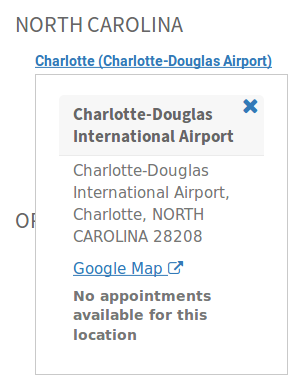Real World APIs: Snagging a Global Entry Interview
As my new job will have me traveling a bit more often, I finally bit the bullet and signed up for Global Entry (which is similar to TSA PreCheck but works for international travel as well). A few days after submitting my application and payment, I was conditionally approved. The next step was to schedule an “interview,” which is essentially a 10-minute appointment where they ask a few questions and take biometrics. The interview must be done in person at one of relatively few CBP locations.
Here in Raleigh, North Carolina, my two closest locations are Richmond and Charlotte. Unfortunately, CBP’s scheduling portal indicated no availability for new appointments at either location. No additional context is provided, so I have no idea whether I should keep trying every few days, or attempt to schedule an appointment at a remote location to coincide with future travel.

My only hope at this point is that spots will eventually open up as other applicants cancel their appointments or CBP adds sufficient staff to meet demand. But that means manually logging into the portal, completing two-factor authentication, and checking both of my desired appointment locations each and every time.
Sounds like a great use Continue reading



